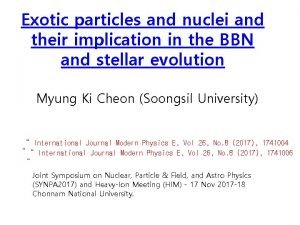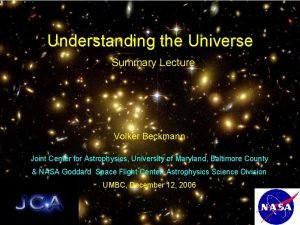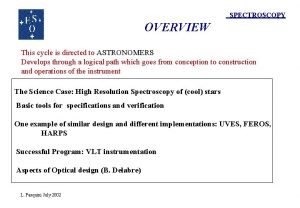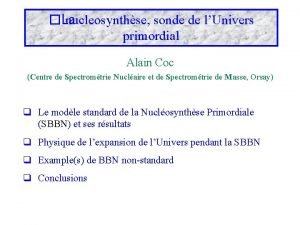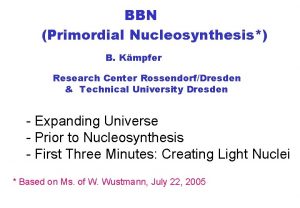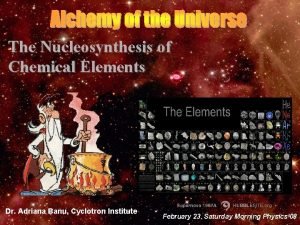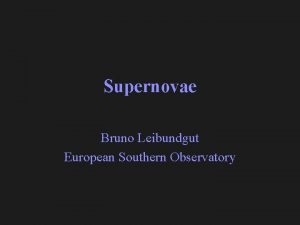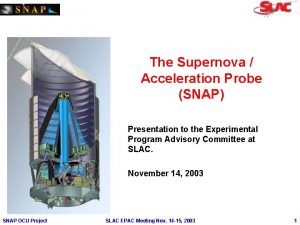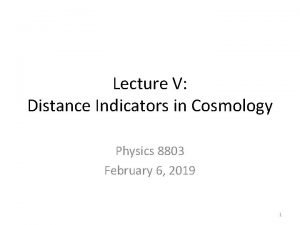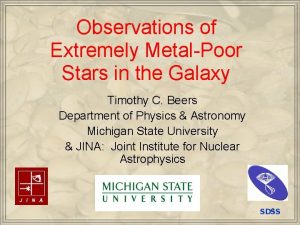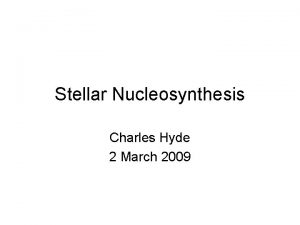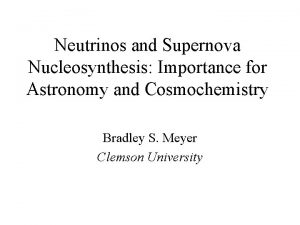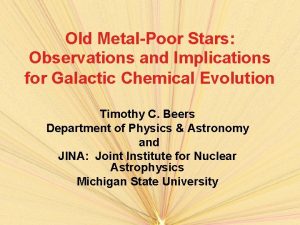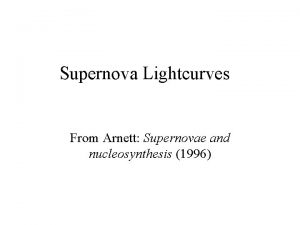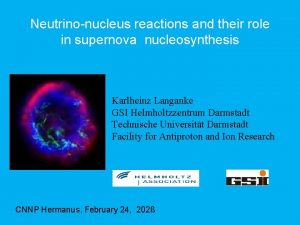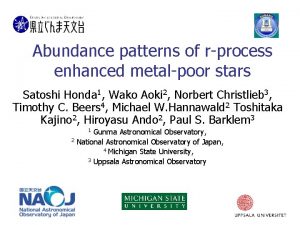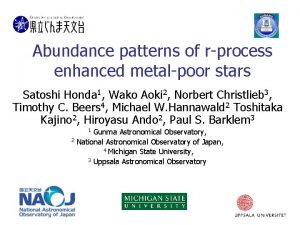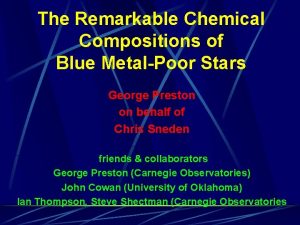Supernova Nucleosynthesis and Extremely MetalPoor Stars Nozomu Tominaga



![Explosive Nucleosynthesis Post-shock Temperature T∝R-3/4 E 1/4 Shock Propagation T [109 K] Fe Complete Explosive Nucleosynthesis Post-shock Temperature T∝R-3/4 E 1/4 Shock Propagation T [109 K] Fe Complete](https://slidetodoc.com/presentation_image/2fc4f54d00711628e4322ed598e78a75/image-4.jpg)


![Dependence: energy deposition rates. . Edep↓: Infall↑ M(Fe)↓ [C/Fe]↑ Edep =120 x 1051 erg/s Dependence: energy deposition rates. . Edep↓: Infall↑ M(Fe)↓ [C/Fe]↑ Edep =120 x 1051 erg/s](https://slidetodoc.com/presentation_image/2fc4f54d00711628e4322ed598e78a75/image-7.jpg)
![Results: M(Fe) & [C/X]. Larger Edep Larger M(Fe) Explosive Smaller M(Fe) . Larger E Results: M(Fe) & [C/X]. Larger Edep Larger M(Fe) Explosive Smaller M(Fe) . Larger E](https://slidetodoc.com/presentation_image/2fc4f54d00711628e4322ed598e78a75/image-8.jpg)





- Slides: 13

Supernova Nucleosynthesis and Extremely Metal-Poor Stars Nozomu Tominaga (Univ. of Tokyo) Collaborators: H. Umeda, K. Maeda, N. Iwamoto, K. Nomoto OMEG 07, 4 -7 Dec. 2007, Hokkaido Univ.

Core-Collapse SNe Massive Star (>10 M 8) e--capture SNe (8 -10 M 8) H He C O Si Fe Temp Burning Products [108 K] Stage 0. 2 1. 5 7 15 30 40 50 H He C Ne O Si NSE He C, O Ne, Mg O, Mg Si Cr, Mn 56 Ni Core collapse Compact object n emission Energy deposition

CCSN Explosion Mechanism Black hole-forming SNe Jet Rapidly-rotating star Core collapse Accretion disk Neutrino Magnetic field Jet formation 35 M 8 star (Mac. Fadyen et al. 99) Jet-induced explosion
![Explosive Nucleosynthesis Postshock Temperature TR34 E 14 Shock Propagation T 109 K Fe Complete Explosive Nucleosynthesis Post-shock Temperature T∝R-3/4 E 1/4 Shock Propagation T [109 K] Fe Complete](https://slidetodoc.com/presentation_image/2fc4f54d00711628e4322ed598e78a75/image-4.jpg)
Explosive Nucleosynthesis Post-shock Temperature T∝R-3/4 E 1/4 Shock Propagation T [109 K] Fe Complete Si burning 5 4 3 Fe, α, Ni, Zn, Co, V Incomplete Si burning Fe, Si, Cr, Mn O burning Si NS/BH R ejecta

Supernova-induced star formation (e. g. , Cioffi et al. 1988) The metal-poor stars are formed by the SN shock compression from the mixture of the materials ejected from SN (Fe, C, O, etc. ) and swept-up by shockwave (H, He). H, He Fe, C, O, Mg, Si, Ca The abundance patterns of EMP stars reflect nucleosynthesis in the parent star and SN.

Jet-induced explosion Jet BH/NS BH cf. “Collapsar”(e. g. , Mac. Fadyen et al. 01) Magnetorotational Supernovae . E (e. g. , Moiseenko et al. 06) dep[erg/s]: parameter Energy deposition rate (NT et al. 07) Mms=40 M 8, Z=0 Edep=1. 5 x 1052 erg
![Dependence energy deposition rates Edep Infall MFe CFe Edep 120 x 1051 ergs Dependence: energy deposition rates. . Edep↓: Infall↑ M(Fe)↓ [C/Fe]↑ Edep =120 x 1051 erg/s](https://slidetodoc.com/presentation_image/2fc4f54d00711628e4322ed598e78a75/image-7.jpg)
Dependence: energy deposition rates. . Edep↓: Infall↑ M(Fe)↓ [C/Fe]↑ Edep =120 x 1051 erg/s . Edep=1. 5 x 1051 erg/s H H He O/C Si Fe O/Mg Infall He O/C Infall
![Results MFe CX Larger Edep Larger MFe Explosive Smaller MFe Larger E Results: M(Fe) & [C/X]. Larger Edep Larger M(Fe) Explosive Smaller M(Fe) . Larger E](https://slidetodoc.com/presentation_image/2fc4f54d00711628e4322ed598e78a75/image-8.jpg)
Results: M(Fe) & [C/X]. Larger Edep Larger M(Fe) Explosive Smaller M(Fe) . Larger E Jet dep EMP stars CEMP stars UMP stars Higher [C/Fe] for smaller M(Fe) (tending to be lower [Fe/H]) HMP [C/Mg] UMP CEMP [C/Fe] [C/O] EMP

Abundance patterns EMP. stars Edep=30 x 1051 erg/s M(56 Ni)~0. 1 M 8 CEMP stars. Edep=3 x 1051 erg/s M(56 Ni)~8 x 10 -4 M 8 HMP. stars Edep=0. 5 -1. 5 x 1051 erg/s M(56 Ni)~3 -4 x 10 -6 M 8

Summary-1 HMP UMP CEMP EMP stars SNe with various E and Mms (NT, Umeda, Nomoto 07) . When Edep is large EMP, CEMP, (UMP), HMP stars. Jet-induced SNe with various Edep

A peculiar EMP stars: HE 1424 -0241 Ø A peculiar Si-deficient star (Cohen et al. 07) Fe Si [Mg/Si]~1. 4 Jet He Mg Si Fe A possible explanation Angular dependent yield (NT 07 ar. Xiv: 0711. 4815) Abundance mixing due to the ISM interaction? ? R/1014 [cm]

Summary-1 HMP UMP CEMP EMP stars SNe with various E and Mms (NT, Umeda, Nomoto 07) . When Edep is large Angular dependence? ? EMP, CEMP, (UMP), HMP stars. Jet-induced SNe with various Edep

Summary-2 Ø Abundance patterns of the EMP stars Ø Jet-induced explosion of stars as massive as SNe in the present days (Mms <100 M 8) Ø Variations of the EMP stars Ø Variation of energy deposition rate Ø Higher [C/Fe] tends to be realized for lower [Fe/H]. Ø Variation of progenitor mass and explosion energy Ø Angular dependence → Outliers of the EMP stars Ø According to the simulation of First Star formation (e. g. , Yoshida et al. 06) Ø First stars are more massive than 100 M 8 Ø Second stars with 40 M 8 are formed from primordial gas?
